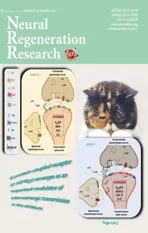目录
- Normal tension glaucoma: from the brain to the eye or the inverse?
- Mesenchymal stromal cell therapy for damaged retinal ganglion cells, is gold all that glitters?
- Diabetic neuropathy research: from mouse models to targets for treatment
- Potential therapeutic roles of retinoids for prevention of neuroinflammation and neurodegeneration in Alzheimer's disease
- Sigma-2 receptor as a potential therapeutic target for treating central nervous system disorders
- Therapeutic implications of advanced age at time of spinal cord injury
- Inducing α-synuclein compaction: a new strategy for inhibiting α-synuclein aggregation?
- Tubulin glutamylation: a skeleton key for neurodegenerative diseases
- Protective potential of glucagon like peptide 2 (GLP-2) against the neurodegeneration
- Antibody-based immunotherapies for Parkinsonian syndromes
- New perspectives in iron chelation therapy for the treatment of Parkinson's disease
- The role of muscle LIM protein in the nervous system
- Micromechanical adaptation as a treatment for spinal cord injury
- G protein-coupled receptor 37(GPR37) emerges as an important modulator of adenosinergic transmission in the striatum
- Mesenchymal stem cells, implications for pain therapy
- Neurogenesis in the hippocampus of adult humans: controversy “fixed” at last
- MK-801 attenuates lesion expansion following acute brain injury in rats: a meta-analysis
- Contralateral C7 transfer combined with acellular nerve allografts seeded with differentiated adipose stem cells for repairing upper brachial plexus injury in rats
- Hyodeoxycholic acid protects the neurovascular unit against oxygen-glucose deprivation and reoxygenation-induced injury in vitro
- The next-generation sphingosine-1 receptor modulator BAF312 (siponimod) improves cortical network functionality in focal autoimmune encephalomyelitis
- Matrine promotes neural circuit remodeling to regulate motor function in a mouse model of chronic spinal cord injury
- Paired associative stimulation improves synaptic plasticity and functional outcomes after cerebral ischemia
- Silencing Huwe1 reduces apoptosis of cortical neurons exposed to oxygen-glucose deprivation and reperfusion
- Association between PPARG genetic polymorphisms and ischemic stroke risk in a northern Chinese Han population: a case-control study
- Atsttrin reduces lipopolysaccharide-induced neuroinflammation by inhibiting the nuclear factor kappa B signaling pathway
- MicroRNA expression in the hippocampal CA1 region under deep hypothermic circulatory arrest
- Pain inhibition through transplantation of fetal neuronal progenitors into the injured spinal cord in rats
- Etomidate affects the anti-oxidant pathway to protect retinal ganglion cells after optic nerve transection
- MicroRNAs as biomarkers of diabetic retinopathy and disease progression
